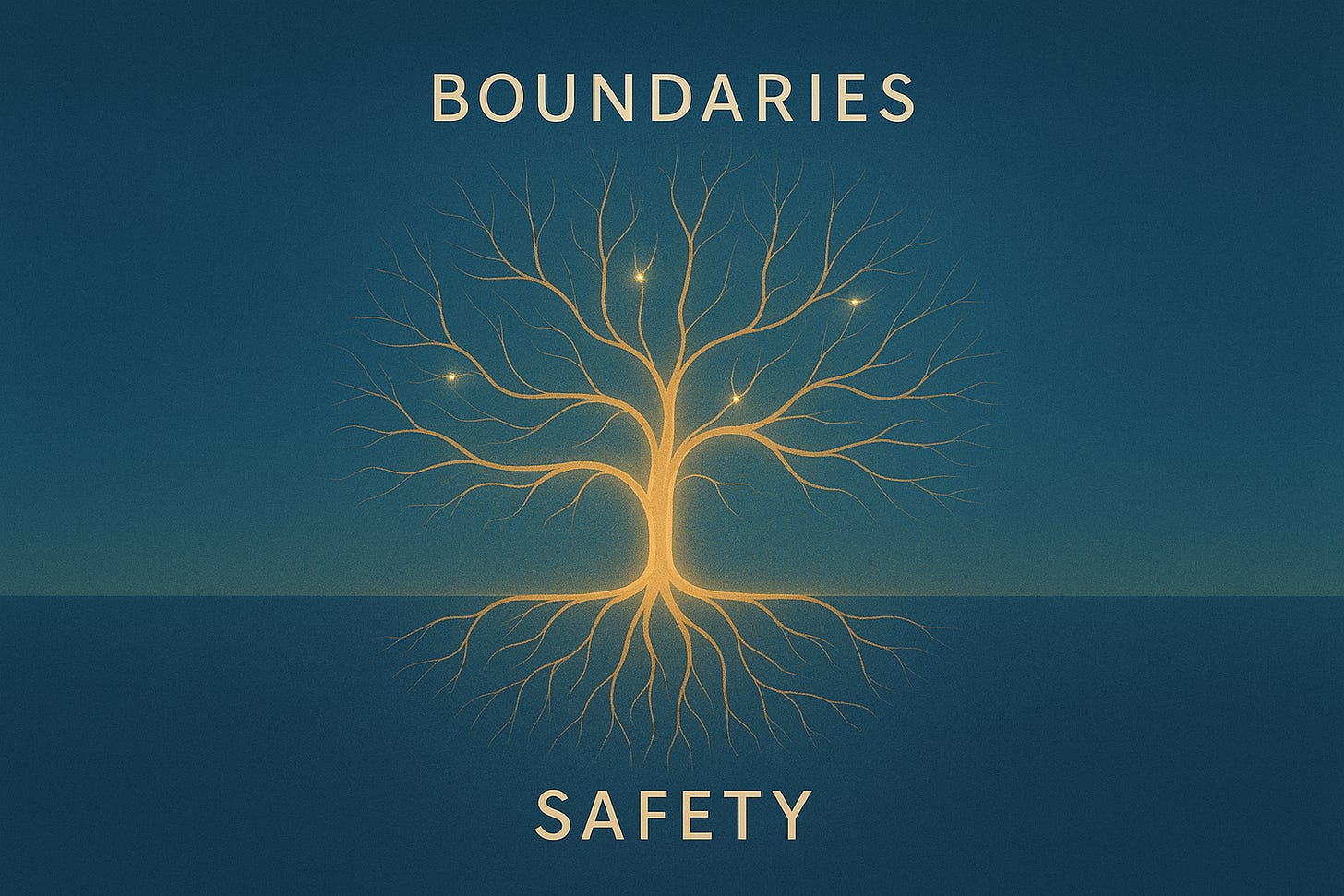Every Expert Talks About Boundaries—But No One Talks About Safety First
Why safety is the missing foundation that makes boundaries finally work.
Boundaries have become the buzzword of modern relationships.
Every expert tells us: “Set your limits.” “Say no without guilt.” “Communicate your needs clearly.”
It sounds simple. Yet most people who try to set boundaries end up feeling like they’ve failed. Either their boundary gets bulldozed, or it creates more conflict instead of less.
Why? Because boundaries don’t work in a vacuum. They need a foundation—safety.
Why Boundaries Without Safety Backfire
Think about the last time you tried to set a boundary. Maybe you told your partner you needed more space. Or you told your friend you couldn’t keep rescuing them.
If the relationship didn’t feel safe, chances are the boundary sounded like rejection. It felt like criticism. It triggered shame, defensiveness, or withdrawal.
What most experts miss is this: the nervous system interprets boundaries through the lens of safety or danger.
When safety is present, a boundary feels like clarity.
When safety is missing, a boundary feels like abandonment or attack.
This is why so many people walk away from books or podcasts about boundaries saying, “It makes sense in theory, but it doesn’t work with my partner.”
Safety: The Soil Beneath the Boundaries
I often tell my clients: safety is the soil, boundaries are the branches. Without fertile soil, the branches snap under the slightest pressure.
Emotional safety means:
I can express myself without fear of punishment.
I can make mistakes without being shamed.
I can say no without losing love.
I can trust that my vulnerability won’t be used against me.
When this kind of safety exists, boundaries stop being weapons or walls. They become doors—ways to let each other in more deeply.
A Client Story
One of my clients, let’s call her Sarah, came to me exhausted. She had read every book on boundaries, but every time she said “no” to her partner, it exploded into an argument.
Her partner wasn’t a bad person. He just didn’t feel safe when she set limits. Her “no” registered in his body as rejection, which triggered old abandonment wounds.
We worked not on stricter boundaries, but on safety first. Sarah learned how to regulate her own nervous system before speaking up. She learned to use soft language like, “I love being with you, and right now I need a little time to recharge so I can come back more present.”
The shift was immediate. Her boundaries started landing not as threats, but as invitations to healthier connection.
How to Create Safety Before You Set a Boundary
Here are a few practices that make boundaries land from safety rather than hurt:
Pause before you speak. If your body feels charged, take 90 seconds to breathe. Regulation changes tone more than words ever can.
Lead with connection. Start by naming your care or intention: “I want us to feel close, and for that I need to be honest.”
Soften the entry. Don’t jump straight into “I feel / I need” if the space isn’t safe yet—it can still trigger defensiveness. Begin with a cue of reassurance: “I know you care about me, and I want to share something so we can feel stronger together.”
Pair truth with reassurance. Example: “I need some space tonight. I’m not pulling away from you—I’m taking this time so I can come back more present.”
Signal partnership. Use language like: “How can we make this work for both of us?” to turn a boundary into collaboration.
These aren’t scripts to memorize. They’re nervous-system signals that say: “We’re safe. We’re on the same side.” Once that foundation is laid, then “I feel” and “I need” statements land in connection instead of conflict.
What This Means for You
If you’ve tried setting boundaries and it led to more distance or conflict, it doesn’t mean boundaries don’t work. It means the step of creating safety first was missing.
Before you draw a line, ask:
Does this relationship feel safe enough for boundaries to be heard?
Am I calm and regulated enough to express this boundary without defensiveness?
Can I frame the boundary in a way that communicates love as well as clarity?
When you focus on safety first, boundaries no longer trigger war. They build bridges.
The Missing Piece in Modern Love
Boundaries are necessary, but they are not the starting point. The starting point is safety—within yourself and between you and the people you love.
Because only when you feel safe can your boundaries become more than defenses. They become expressions of self-respect, rooted in connection, not fear.
And here’s the hope: you don’t have to wait for someone else to create that safety for you. You can begin right now by cultivating it inside yourself.
That might look like:
Noticing when your body tenses and pausing to breathe.
Reminding yourself, “It’s okay to take up space.”
Choosing compassion instead of criticism when you stumble.
Offering your nervous system cues of safety — stillness, grounding, warmth — before speaking your truth.
When you build safety within yourself first, boundaries stop feeling like ultimatums. They become natural extensions of your inner steadiness.
And that’s what turns boundaries from breaking points into building blocks of love that actually lasts.



